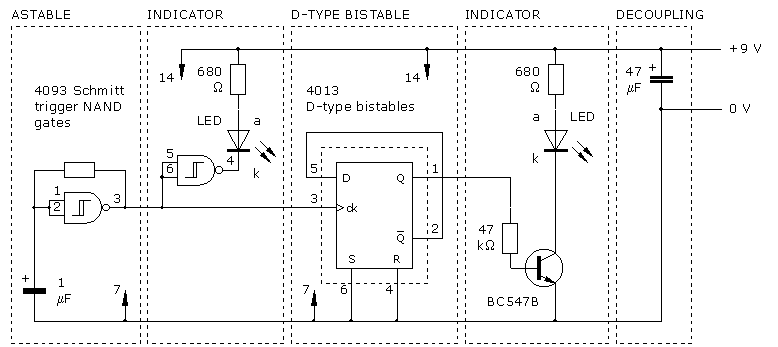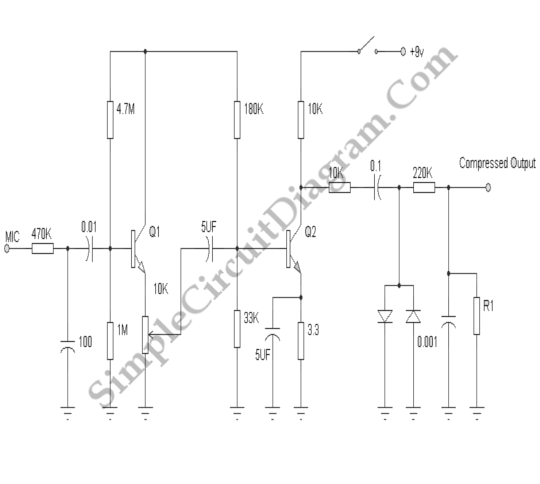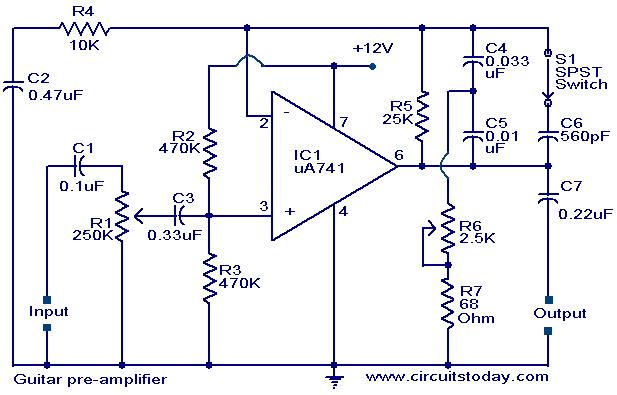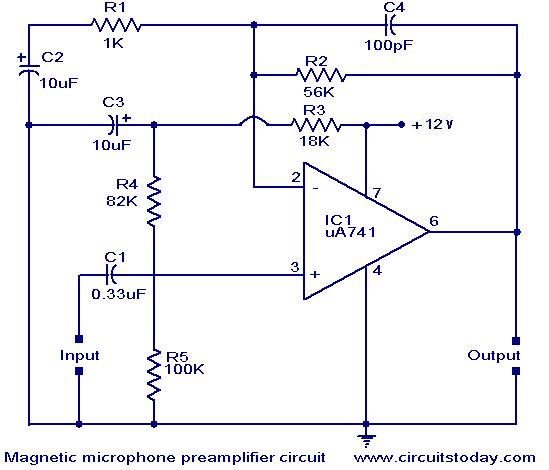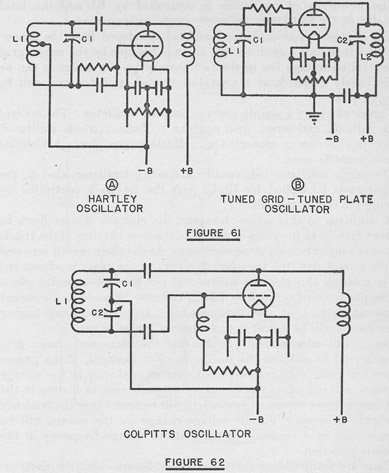
Servicing the Hammond B-3 Type Pre-Amp
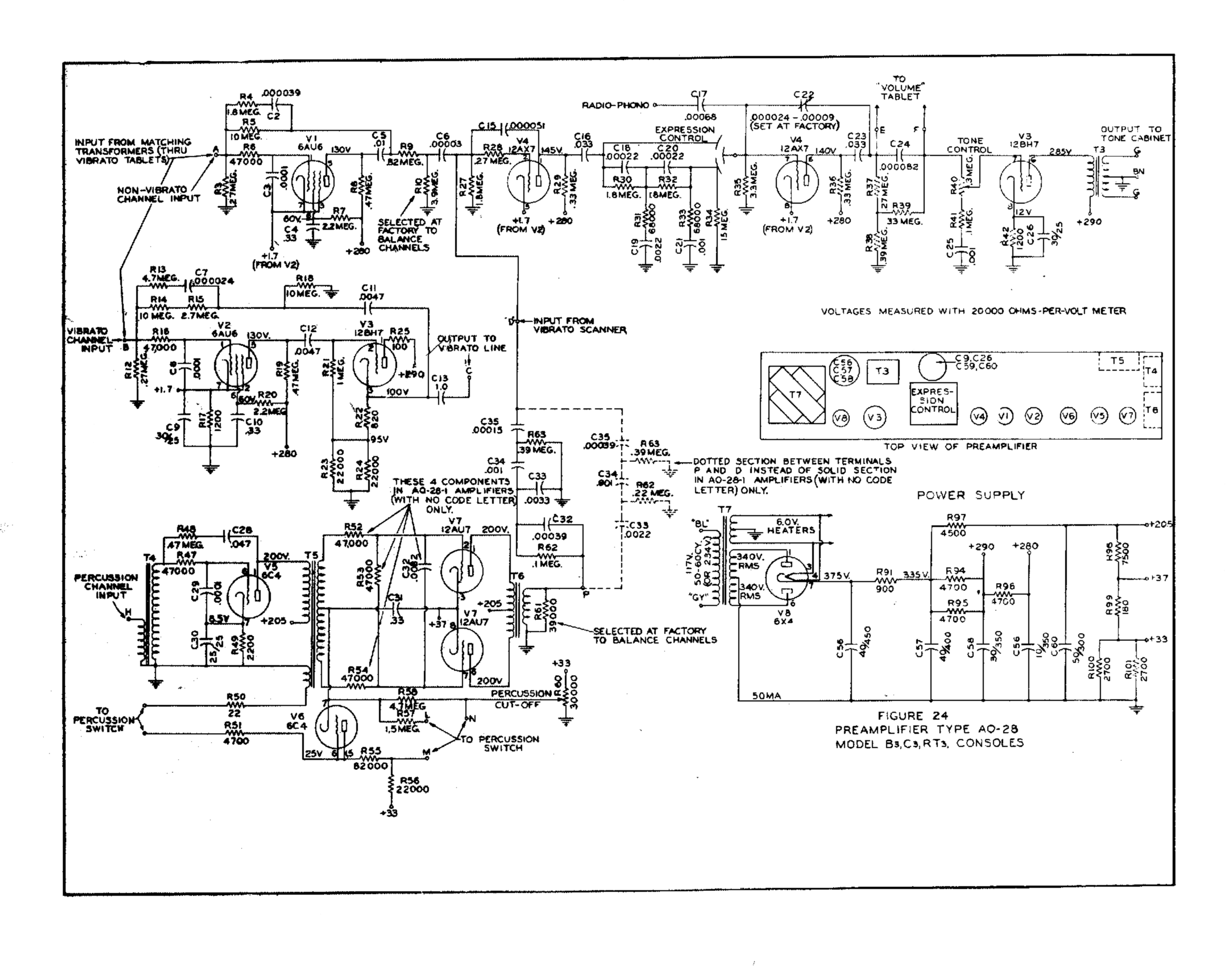
Designed in the 1950s, this preamplifier remained in production until 1975 and is still fully functional and serviceable today. This discussion aims to assist owners with basic troubleshooting and provides an in-depth look at circuit operation as well as common issues typically encountered. When the vibrato switches are set to "off," the signal from the matching transformer is directed to Point A, a solder terminal located on the preamp. If there is an issue with the non-vibrato sound, it is likely in this area. The signal is routed to the input grid (pin 1) of the 6AU6A tube for amplification. The voltages indicated are usually the first items to check. If the tube is functioning properly, the two most likely sources of problems will be R6 (the plate load resistor) or R7 (the screen grid resistor). If the plate voltage reads low, R6 is likely failing (opening). Conversely, if the plate voltage is high, then R7 may be failing (opening). The vibrato input circuit is similar to the non-vibrato path, with a few differences. First, the 1.7 Vdc reference voltage is created at pin 7 of V2 and is used by several other tubes. Secondly, the output is directed to the vibrato delay line driver tube, which is one-half of the V3, the 12BH7A output tube. The plate and screen voltages on V2 should be checked similarly to the previous tube. Additionally, the voltages on V3 must be verified; any loss of amplification here will result in weak or non-functional vibrato. V4 is a dual triode tube where the first stage (V4a) accepts signals from the non-vibrato preamp, the vibrato scanner, and the percussion circuit. These signals are amplified to a sufficient level to drive the expression control. The primary service concern here is the plate voltage; if it is low, R29 (the plate load resistor) is likely failing (opening). If it is high and there is no screen grid, the tube itself may be defective. In the expression control circuit, two plates are shown after V4(a), along with a third movable plate leading into the next stage of V4(b). The higher plate connects directly to the output of V4(a), while the lower plate contains some RC (resistive-capacitive) circuits. If the movable plate is closer to the higher stationary plate, the volume is louder. As it moves toward the lower stationary plate, the volume decreases. The RC network causes a tone change, attenuating high frequencies more quickly than low frequencies. This means that at lower volumes, bass frequencies remain more pronounced than highs, mimicking a loudness curve found in home stereo systems. The second stage of V4(b) amplifies the signal from the expression control and sends it to the output stage through the tone control. Again, the plate voltage is the primary parameter to check to determine if the tube or plate load resistor is faulty. A failure in either stage of V4 will typically result in a complete loss of sound from the organ. The tone control is a passive circuit that primarily attenuates high frequencies. It can present issues if the potentiometer (R40) is scratchy; cleaning with a quality cleaner such as De-oxit is recommended when the preamp is exposed. C22, a feedback capacitor in the second stage of V4(b), takes some output from V4(b) and sends it back to its input. Since the output is 180 degrees out of phase with the input, it reduces the gain of that stage. This component is factory-set and should generally be adjusted by turning the screw in the expression box clockwise all the way in, then counterclockwise by 1.5 turns. This setting should not be used as a volume control, as it affects both volume and frequency response. The volume soft/loud tab connects at the E and F terminals, and shorting C24 raises the volume. A common issue when switching the soft/loud tab is a thump or pop sound, often due to C23 failing (leaking DC). V3 acts as the final amplifier of the preamp; the 12BH7A is a dual triode where one stage handles preamp output while the other drives the vibrato delay line after V2. The signal is taken from the tone control, entering pin 7 of the input grid, and outputs on the plate to drive the output transformer. Key checkpoints include pin 6 (plate) and pin 8 (cathode). A shorted C26 may cause low cathode voltage, while an open R42 can lead to excessive voltage and result in little or no amplification. Output transformers rarely fail, making a loss of plate voltage unlikely. The transformer converts the single-ended signal into a balanced signal, with output at the GG terminals. A quick method to assess the overall gain of the preamp is to turn the expression pedal fully up, pull out the four lower drawbars on either manual, and play a C chord in the middle of the manual, expecting to read about 3 to 4 Vac across the GG terminals. The percussion channel input terminal H receives its signal from the percussion switches, either the second or third harmonic. This signal enters T4 transformer and V5 (6C4), the first amplification stage, where issues are typically limited to tube failures. T5 converts the single-ended signal to a balanced signal, driving the balanced amplifier V7 (12AU7A). The third winding on T5 carries the selected percussion harmonic borrowed from the drawbar and replaces it through R50 and terminal J. By changing the voltage on the input grids, the gain of V7 can be adjusted through the center tap of T5's secondary winding, controlled by V6 (6C4). The percussion cutoff control sets the bias of V7, adjusting the decay speed of the percussion. When a key is pressed, the signal plays loudly through the control tube, transformer T6, a high-pass filter, and terminal D to the grid of V4. The condenser C31 in the control tube grid circuit begins to discharge, causing the signal to fade. Terminal K (approximately 25 Vdc) connects to the first drawbar wire linked to the manual busbar. When an upper manual key is pressed, terminal K is grounded through the tone generator filters, effectively grounding the plate of V6 (configured as a diode), halting conduction and isolating the cathode and control tube grid circuit. The grid voltage drifts from approximately +25 Vdc to about +15 Vdc at a rate determined by the discharge time of C31 through R57 and R58. Once this sequence completes, the percussion signal is blocked until all upper manual keys are released, allowing the control grids to rise again to +25 Vdc, with the rise rate fixed by the time required to charge C31 through R55 and R56. With all three percussion tubes removed, the organ will still function normally, albeit without percussion. Transformers typically present minimal issues but can fail, sometimes causing static that can only be resolved by replacing the faulty transformer. In emergencies, percussion tubes can be removed to eliminate static, allowing the organ to operate without percussion. These transformers are no longer available but can be sourced from used instruments, including the smaller and less expensive M-3 series organs. To set the percussion cutoff control, a key should be depressed with no drawbars engaged and percussion activated, adjusting the control until the sound fades completely, then turning it the opposite direction until it fades out again. Further adjustments can be made to achieve the desired decay effect.Designed in the fifties, this pre-amp remained in production until 1975. And, it remains fully functional and serviceable today. This discussion is designed to help owners do some basic troubleshooting and, we`ll get into some depth of circuit operation as well as common problems usually found here. If the vibrato switches are set to vibrato off, the signal from the matching transformer goes into Point A , a solder terminal located on the preamp. If you had a problem with the non-vibrato sound, it would likely be in this area. Basically the signal is routed to the input grid (pin 1) of the 6AU6A tube for amplification. The voltages shown are usually the first thing to check. If the tube is good, then the two most likely sources of problems will be R6 (plate load resistor) or R7 (screen grid resistor).
If you check the plate voltage for example and it reads low, then the plate load resistor R6 is probable going bad. (opening up) If however the voltage on the plate reads high, then the screen grid resistor R7 is going bad.
(opening up). The vibrato input is nearly the same as the above but for a few differences. First, the 1. 7Vdc is actually created here on V2 ²s pin 7. This reference voltage is used on several other tubes. Second, the output goes into the vibrato delay line driver tube. This is one-half of V3, the 12BH7A output tube. Again the plate and screen voltages should be checked on V2 like above. Additionally, the voltages on V3 should be checked. Any loss of amplification here will cause the vibrato to either be weak or not work. V4 is a dual triode tube. The first stage V4a accepts signals from the non-vibrato preamp, the vibrato scanner, and the percussion circuit. These signals are again amplified to a sufficient level to drive the expression control. The main service concern here would be the plate voltage. If the plate voltage is low, then the plate load resistor R29 is likely going bad (opening up). If it is high, and since there is no screen grid, the tube itself is likely going bad. In the expression control circuit, you will see there are two plates shown after V4(a), and a third movable plate shown going into the next stage of V4b.
The higher plate is connected directly to the output of V4a, while the lower plate has some RC (resistive/capacitive) circuits shown. If the movable plate is closer to the higher stationary plate, the volume is louder. As it moves to the lower stationary plate, it gets softer. Because of the RC network, the signal also gets a tone change. In other words, the high frequencies are attenuated faster than the lower frequencies. This means at lower volumes, the bass will actually remain more present than the highs. Since we hear different frequencies differently at different volumes, (see fletcher-munson curves ) this acts like a loudness curve in a home stereo.
The second stage of V4(b) picks up the signal from the expression control, amplifies it and sends it to the output stage through the tone control. Again the plate voltage is the primary check. Determine if the tube or plate load resistor is bad. A failure in either stage of V4 will usually kill all sound in the organ. The tone control is a passive circuit and in reality, it only attenuates the highs. It can be a source of problems if the potentiometer R40 is scratchy. If you have the preamp turned up to expose the underside, always clean this pot with some good quality cleaner such as De-oxit.
Notice C22 which is a feedback capacitor in the second stage of V4(b). This cap takes some of the output from V4(b) and sends it to its input. Since the output is 180 degrees out of phase with the input, it reduces the gain of that stage. It is set at the factory and in general, you set it by turning the screw located in the expression box clockwise all the way in. Then turn it counter clockwise 1 1/2 turns. This should not be played with as a volume control. Even though it does affect the volume, it also affects the frequency response and should be set close to the factory setting.
Also notice the reference to the volume tablet and the E and F terminals. This is where the volume soft/loud tab connects. By shorting out C24, the volume is raised. I mention this because there is a typical problem where when switching the soft/loud tab, you hear a thump or pop. This is due to C23 going bad. (leaking DC) V3 is the final amplifier of the preamp. This 12BH7A is a dual triode where one stage is for preamp output and the other is used after the V2 vibrato preamp to drive the vibrato delay line.
The signal is taken from the tone control, goes into pin 7 input grid, and outputs on the plate to drive the output transformer. Obvious check points are pin 6 plate and pin 8 cathode. A shorted C26 could cause the cathode voltage to be low. An open R42 could cause it to go way up and result in little or no amplification. Output transformers rarely fail so a loss of plate voltage is unlikely. The transformer converts the single ended signal into a balanced signal. It`s output is the famous GG terminals. A quick check of the overall gain of the preamp is to turn the expression pedal all the way up. Pull out the four lower drawbars on either manual. Play a C chord in the middle of the manual. You should read about 3 to 4 Vac across the GG terminals. The percussion channel input terminal H gets its signal from the percussion switches. Either the second or third harmonic. The signal enters T4 transformer and V5 (6C4), the first stage of amplification. Not many problems in this circuit other than the occasional tube failure. T5 takes the single ended signal and changes it to a balanced signal. It drives the balanced amplifier V7 (12AU7A). Notice the third winding on T5. This carries the selected percussion harmonic that was borrowed from its drawbar back and replaces the borrowed harmonic through R50 and terminal J.
By changing the voltage on the input grids, the gain of V7 can be varied. This is done through the center tap of T5 ²s secondary winding controlled by V6 (6C4). The percussion cutoff control sets the bias of V7 which adjusts the decay speed of the percussion. When a key is depressed the signal first plays loudly through the control tube, transformer T6, a high pass filter, and terminal D to the grid of V4. Immediately condenser C31 in the control tube grid circuit begins to discharge, causing the signal to fade away.
Terminal K (Approx 25Vdc) is connected to the 1 ² drawbar wire which is connected to the manual busbar. When an upper manual key is pressed, terminal K is grounded through the tone generator filters. This virtually grounds the plate of V6 (connected as a diode), stops conduction, and isolates cathode and control tube grid circuit.
The grid then drifts from approx +25Vdc to about +15Vdc, at a rate determined by the time required for C31 to discharge through R57 and R58. At the completion of this sequence the percussion signal is blocked. No further percussion effects occur until all keys of the upper manual are released and the control grids can again rise to +25Vdc.
The rate of this rise is fixed by the time required to charge C31 to +25Vdc through R55 and R56. With all three percussion tubes removed, the organ will play normally, just no percussion. The transformers give little to no trouble but can fail. In some cases, cause static that can only be removed by replacing the offending transformer. In an emergency, you can pull the percussion tubes to get rid of the static and operate the organ with no percussion. These transformers are NLA but can be acquired from used instruments including the smaller and much cheaper M-3 series organs.
To set the percussion cutoff control, depress a key with no drawbars out and the percussion on. The sound should fade out completely. Adjust the control until the sound can be heard. Then turn it the other way until if fades out completely. You can further adjust it for the amount of decay you prefer. 🔗 External reference
If you check the plate voltage for example and it reads low, then the plate load resistor R6 is probable going bad. (opening up) If however the voltage on the plate reads high, then the screen grid resistor R7 is going bad.
(opening up). The vibrato input is nearly the same as the above but for a few differences. First, the 1. 7Vdc is actually created here on V2 ²s pin 7. This reference voltage is used on several other tubes. Second, the output goes into the vibrato delay line driver tube. This is one-half of V3, the 12BH7A output tube. Again the plate and screen voltages should be checked on V2 like above. Additionally, the voltages on V3 should be checked. Any loss of amplification here will cause the vibrato to either be weak or not work. V4 is a dual triode tube. The first stage V4a accepts signals from the non-vibrato preamp, the vibrato scanner, and the percussion circuit. These signals are again amplified to a sufficient level to drive the expression control. The main service concern here would be the plate voltage. If the plate voltage is low, then the plate load resistor R29 is likely going bad (opening up). If it is high, and since there is no screen grid, the tube itself is likely going bad. In the expression control circuit, you will see there are two plates shown after V4(a), and a third movable plate shown going into the next stage of V4b.
The higher plate is connected directly to the output of V4a, while the lower plate has some RC (resistive/capacitive) circuits shown. If the movable plate is closer to the higher stationary plate, the volume is louder. As it moves to the lower stationary plate, it gets softer. Because of the RC network, the signal also gets a tone change. In other words, the high frequencies are attenuated faster than the lower frequencies. This means at lower volumes, the bass will actually remain more present than the highs. Since we hear different frequencies differently at different volumes, (see fletcher-munson curves ) this acts like a loudness curve in a home stereo.
The second stage of V4(b) picks up the signal from the expression control, amplifies it and sends it to the output stage through the tone control. Again the plate voltage is the primary check. Determine if the tube or plate load resistor is bad. A failure in either stage of V4 will usually kill all sound in the organ. The tone control is a passive circuit and in reality, it only attenuates the highs. It can be a source of problems if the potentiometer R40 is scratchy. If you have the preamp turned up to expose the underside, always clean this pot with some good quality cleaner such as De-oxit.
Notice C22 which is a feedback capacitor in the second stage of V4(b). This cap takes some of the output from V4(b) and sends it to its input. Since the output is 180 degrees out of phase with the input, it reduces the gain of that stage. It is set at the factory and in general, you set it by turning the screw located in the expression box clockwise all the way in. Then turn it counter clockwise 1 1/2 turns. This should not be played with as a volume control. Even though it does affect the volume, it also affects the frequency response and should be set close to the factory setting.
Also notice the reference to the volume tablet and the E and F terminals. This is where the volume soft/loud tab connects. By shorting out C24, the volume is raised. I mention this because there is a typical problem where when switching the soft/loud tab, you hear a thump or pop. This is due to C23 going bad. (leaking DC) V3 is the final amplifier of the preamp. This 12BH7A is a dual triode where one stage is for preamp output and the other is used after the V2 vibrato preamp to drive the vibrato delay line.
The signal is taken from the tone control, goes into pin 7 input grid, and outputs on the plate to drive the output transformer. Obvious check points are pin 6 plate and pin 8 cathode. A shorted C26 could cause the cathode voltage to be low. An open R42 could cause it to go way up and result in little or no amplification. Output transformers rarely fail so a loss of plate voltage is unlikely. The transformer converts the single ended signal into a balanced signal. It`s output is the famous GG terminals. A quick check of the overall gain of the preamp is to turn the expression pedal all the way up. Pull out the four lower drawbars on either manual. Play a C chord in the middle of the manual. You should read about 3 to 4 Vac across the GG terminals. The percussion channel input terminal H gets its signal from the percussion switches. Either the second or third harmonic. The signal enters T4 transformer and V5 (6C4), the first stage of amplification. Not many problems in this circuit other than the occasional tube failure. T5 takes the single ended signal and changes it to a balanced signal. It drives the balanced amplifier V7 (12AU7A). Notice the third winding on T5. This carries the selected percussion harmonic that was borrowed from its drawbar back and replaces the borrowed harmonic through R50 and terminal J.
By changing the voltage on the input grids, the gain of V7 can be varied. This is done through the center tap of T5 ²s secondary winding controlled by V6 (6C4). The percussion cutoff control sets the bias of V7 which adjusts the decay speed of the percussion. When a key is depressed the signal first plays loudly through the control tube, transformer T6, a high pass filter, and terminal D to the grid of V4. Immediately condenser C31 in the control tube grid circuit begins to discharge, causing the signal to fade away.
Terminal K (Approx 25Vdc) is connected to the 1 ² drawbar wire which is connected to the manual busbar. When an upper manual key is pressed, terminal K is grounded through the tone generator filters. This virtually grounds the plate of V6 (connected as a diode), stops conduction, and isolates cathode and control tube grid circuit.
The grid then drifts from approx +25Vdc to about +15Vdc, at a rate determined by the time required for C31 to discharge through R57 and R58. At the completion of this sequence the percussion signal is blocked. No further percussion effects occur until all keys of the upper manual are released and the control grids can again rise to +25Vdc.
The rate of this rise is fixed by the time required to charge C31 to +25Vdc through R55 and R56. With all three percussion tubes removed, the organ will play normally, just no percussion. The transformers give little to no trouble but can fail. In some cases, cause static that can only be removed by replacing the offending transformer. In an emergency, you can pull the percussion tubes to get rid of the static and operate the organ with no percussion. These transformers are NLA but can be acquired from used instruments including the smaller and much cheaper M-3 series organs.
To set the percussion cutoff control, depress a key with no drawbars out and the percussion on. The sound should fade out completely. Adjust the control until the sound can be heard. Then turn it the other way until if fades out completely. You can further adjust it for the amount of decay you prefer. 🔗 External reference
